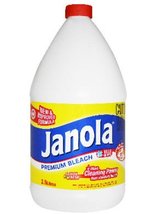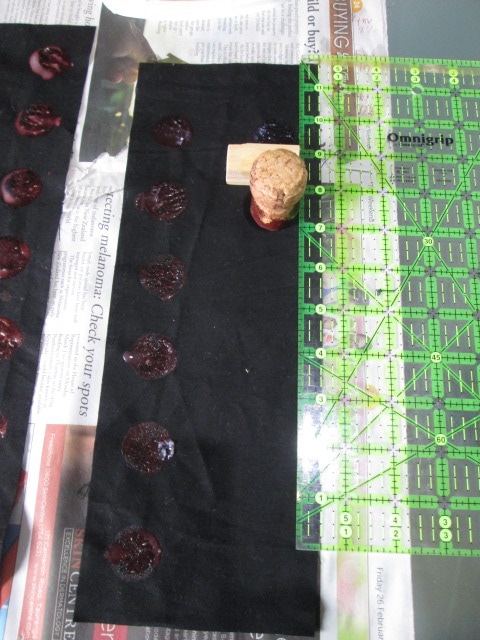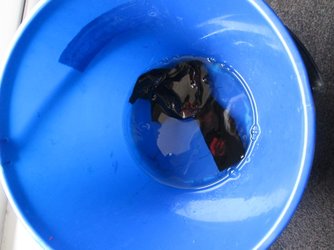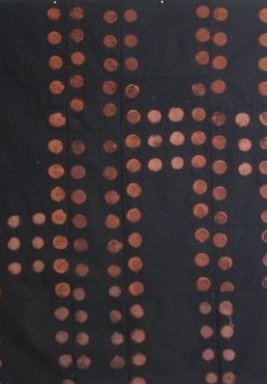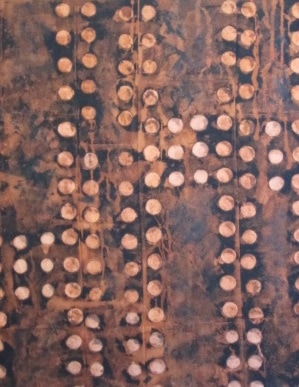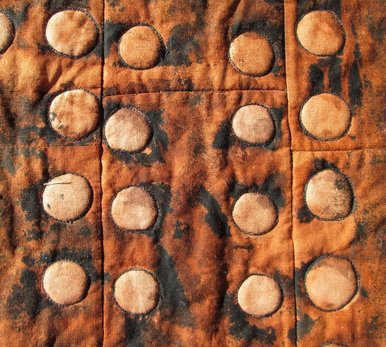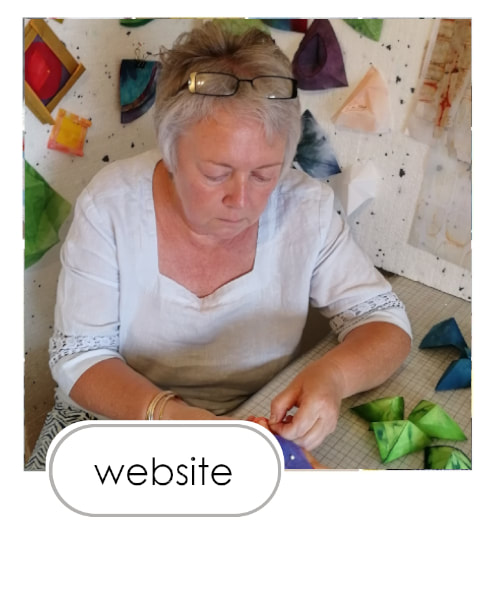|
I've been working on a new quilt for a while now, for the SAQA 'Made in Europe II' exhibition. I am hoping it will be selected to hang in their gallery at Festival of Quilts later this year. It isn't what you would call a 'pretty' quilt, but it is part of the ongoing work I have made this year in terms of its style and inspiration.
The quilt itself is of fairly simple construction, (much like the others) being made from irregularly sized rectangles pieced together, so nothing much to write home about there. The fun in this quilt has come from creating a particular effect on the fabric I used. I was aiming for a very specific visual texture, the look of iron metal that has been painted and then blistered by rust beneath the surface. The process of creating it was an interesting journey, so I thought I would share a little of the process I used to create it.
I decided to start with a large piece of commercially dyed black homespun fabric and then remove some of the colour from it. In the past I have used both formusol and discharge paste to remove colour from fabrics, but neither was readily available to me here, so I got out the bleach did some experimenting to find the best way to get the results I had in mind. As it turns out, it worked brilliantly - so much so, I may never bother with the smelly formusol ever again!
Interestingly enough, here in New Zealand bleach is comparatively expensive. I have no idea why! In the UK it is dirt cheap. I sought out the least expensive bleach I could find - it turned out to be the thin watery stuff - and tried various ways to thicken it so it would be more controllable.
I started with manutex - the sodium alginate seaweed based thickener I usually use with dye: Sadly it was no good. The bleach completely destroyed the viscosity. Dharma Trading sell a thickener for bleach made by Jacquard (click here to go to their website), but I would have had to import it from the USA and I didn't want to wait for it to arrive, so my search continued. I found out about fumed silica (click here to find out about this interesting stuff) which would apparently work very well (maybe that is what is in the Jacquard stuff??), but again I would have to order it. So I decided to try plain old starch - cornflour in water. I mixed two big spoonfuls of cornflour into a little cold water to make a slurry then added another half a cup or so of water and and popped it into the microwave. A few seconds later I had a very thick, gooey transparent paste. I mixed in some thin bleach and gave it all a good stir. It stayed thick and allowed me to draw, dribble and stamp the bleachy paste onto the black fabric. For a cheap and practical solution to my needs the cornflour paste was perfect! Note: Interestingly, the left over bleachy paste did break down overnight and became thin and runny - so I recommend mixing the the bleach and paste as you need it rather than making a big batch. There is some debate as to how much damage bleach does to fabric when used to remove colour (discharge) in this way. To be honest, I have used bleach to remove colour several times in the past, and never had any problems. The fabrics still seem to be in good condition and I see no problems on the horizon. Maybe in 20 or more years there will be - but so far so good. However, in the interest of being thorough I researched how to neutralise the bleach and stop any potential damage. There are a number of methods various people recommend. The one NOT to do is to dip the discharged fabric into a mixture of vinegar and water. The (faulty) logic goes like this: bleach is alkaline, so neutralise it with an acid. Apparently it is not quite as straightforward as it seems (is anything???) Paula Birch has a very good explanation of the different methods on her website, which you can find here: www.pburch.net/dyeing/FAQ/neutralizingdischarge.shtml I opted for the hydrogen peroxide as it was the cheapest and easiest to obtain, not to mention that it seems less noxious. Paula Birch recommends 3% peroxide, which translates to 10 vol if you are more used to that measurement. (As a long term experiment I have kept 3 pieces of the discharged black fabric. One has not been neutralised at all, just rinsed in water, the second has been neutralised in the dreaded diluted vinegar and the third in peroxide. Time will tell if there is any difference!)
By this stage I was pretty happy with the effect. To me it is beginning to resemble a section of painted iron. I have since added some further fabric and begun the process of hand stitching various knots over the surface to give it even more texture.
The closing date for entries to the 'Made in Europe II' SAQA exhibition is 31st May - so I had better get on with it! http://saqacallforentrymadeineurope2.com/ Thanks for reading.
|
|
